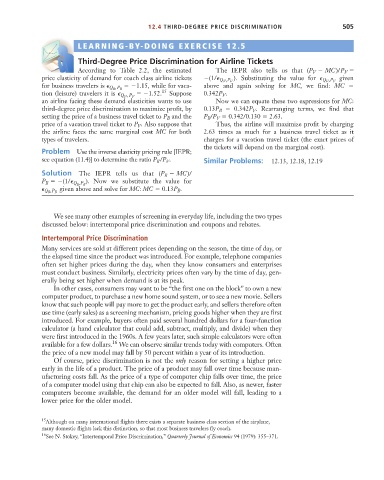Page 531 - Microeconomics, Fourth Edition
P. 531
c12capturingsurplus.qxd 7/22/10 10:41 AM Page 505
12.4 THIRD-DEGREE PRICE DISCRIMINATION 505
LEARNING-BY-DOING EXERCISE 12.5
S
D
E
Third-Degree Price Discrimination for Airline Tickets
According to Table 2.2, the estimated The IEPR also tells us that (P V MC)/P V
price elasticity of demand for coach class airline tickets (1/ Q V ,P V ). Substituting the value for Q V ,P V given
1.15, while for vaca- above and again solving for MC, we find: MC
for business travelers is Q B ,P B
1.52. 15 Suppose 0.342P V .
tion (leisure) travelers it is Q V , P V
an airline facing these demand elasticities wants to use Now we can equate these two expressions for MC:
third-degree price discrimination to maximize profit, by 0.13P B 0.342P V . Rearranging terms, we find that
setting the price of a business travel ticket to P B and the P B /P V 0.342/0.130 2.63.
price of a vacation travel ticket to P V . Also suppose that Thus, the airline will maximize profit by charging
the airline faces the same marginal cost MC for both 2.63 times as much for a business travel ticket as it
types of travelers. charges for a vacation travel ticket (the exact prices of
the tickets will depend on the marginal cost).
Problem Use the inverse elasticity pricing rule [IEPR;
see equation (11.4)] to determine the ratio P B /P V . Similar Problems: 12.13, 12.18, 12.19
Solution The IEPR tells us that (P B MC) /
). Now we substitute the value for
P B (1/ Q B ,P B
given above and solve for MC: MC 0.13P B .
Q B ,P B
We see many other examples of screening in everyday life, including the two types
discussed below: intertemporal price discrimination and coupons and rebates.
Intertemporal Price Discrimination
Many services are sold at different prices depending on the season, the time of day, or
the elapsed time since the product was introduced. For example, telephone companies
often set higher prices during the day, when they know consumers and enterprises
must conduct business. Similarly, electricity prices often vary by the time of day, gen-
erally being set higher when demand is at its peak.
In other cases, consumers may want to be “the first one on the block” to own a new
computer product, to purchase a new home sound system, or to see a new movie. Sellers
know that such people will pay more to get the product early, and sellers therefore often
use time (early sales) as a screening mechanism, pricing goods higher when they are first
introduced. For example, buyers often paid several hundred dollars for a four-function
calculator (a hand calculator that could add, subtract, multiply, and divide) when they
were first introduced in the 1960s. A few years later, such simple calculators were often
16
available for a few dollars. We can observe similar trends today with computers. Often
the price of a new model may fall by 50 percent within a year of its introduction.
Of course, price discrimination is not the only reason for setting a higher price
early in the life of a product. The price of a product may fall over time because man-
ufacturing costs fall. As the price of a type of computer chip falls over time, the price
of a computer model using that chip can also be expected to fall. Also, as newer, faster
computers become available, the demand for an older model will fall, leading to a
lower price for the older model.
15 Although on many international flights there exists a separate business class section of the airplane,
many domestic flights lack this distinction, so that most business travelers fly coach.
16 See N. Stokey, “Intertemporal Price Discrimination,” Quarterly Journal of Economics 94 (1979): 355–371.

